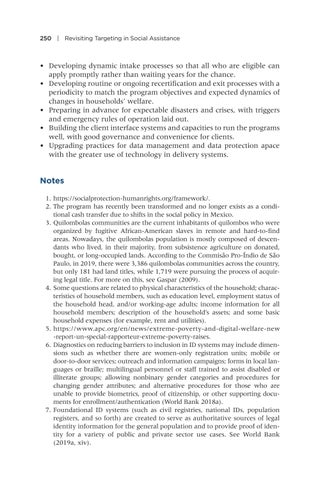250 | Revisiting Targeting in Social Assistance
• Developing dynamic intake processes so that all who are eligible can apply promptly rather than waiting years for the chance. • Developing routine or ongoing recertification and exit processes with a periodicity to match the program objectives and expected dynamics of changes in households’ welfare. • Preparing in advance for expectable disasters and crises, with triggers and emergency rules of operation laid out. • Building the client interface systems and capacities to run the programs well, with good governance and convenience for clients. • Upgrading practices for data management and data protection apace with the greater use of technology in delivery systems.
Notes 1. https://socialprotection-humanrights.org/framework/. 2. The program has recently been transformed and no longer exists as a conditional cash transfer due to shifts in the social policy in Mexico. 3. Quilombolas communities are the current inhabitants of quilombos who were organized by fugitive African-American slaves in remote and hard-to-find areas. Nowadays, the quilombolas population is mostly composed of descendants who lived, in their majority, from subsistence agriculture on donated, bought, or long-occupied lands. According to the Commisão Pro-Índio de São Paulo, in 2019, there were 3,386 quilombolas communities across the country, but only 181 had land titles, while 1,719 were pursuing the process of acquiring legal title. For more on this, see Gaspar (2009). 4. Some questions are related to physical characteristics of the household; characteristics of household members, such as education level, employment status of the household head, and/or working-age adults; income information for all household members; description of the household’s assets; and some basic household expenses (for example, rent and utilities). 5. https://www.apc.org/en/news/extreme-poverty-and-digital-welfare-new -report-un-special-rapporteur-extreme-poverty-raises. 6. Diagnostics on reducing barriers to inclusion in ID systems may include dimensions such as whether there are women-only registration units; mobile or door-to-door services; outreach and information campaigns; forms in local languages or braille; multilingual personnel or staff trained to assist disabled or illiterate groups; allowing nonbinary gender categories and procedures for changing gender attributes; and alternative procedures for those who are unable to provide biometrics, proof of citizenship, or other supporting documents for enrollment/authentication (World Bank 2018a). 7. Foundational ID systems (such as civil registries, national IDs, population registers, and so forth) are created to serve as authoritative sources of legal identity information for the general population and to provide proof of identity for a variety of public and private sector use cases. See World Bank (2019a, xiv).


